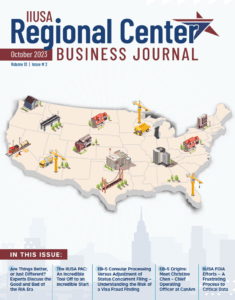 Commissioned by IIUSA earlier this year, the economic impact analysis company Minnesota IMPLAN Group (MiG), presented the Economic Impacts of the EB-5 Immigration Program 2010-2011 Report, which highlights beneficial economic impacts of the EB-5 Program. The report is also peer-reviewed by the Association for Univeristy Business Economic Research (AUBER) and is an important tool for industry stakeholders, particularly in advocacy efforts. The primary analyst working on the publication, David Kay of MiG, Inc., presented the findings of the economic impact analysis at IIUSA’s 3rd Annual International Investment and Economic Development Forum in Las Vegas this past June. The report in its entirety is for sale at IIUSA’s online store and Mr. Kay’s presentation from June available for download for free.
Commissioned by IIUSA earlier this year, the economic impact analysis company Minnesota IMPLAN Group (MiG), presented the Economic Impacts of the EB-5 Immigration Program 2010-2011 Report, which highlights beneficial economic impacts of the EB-5 Program. The report is also peer-reviewed by the Association for Univeristy Business Economic Research (AUBER) and is an important tool for industry stakeholders, particularly in advocacy efforts. The primary analyst working on the publication, David Kay of MiG, Inc., presented the findings of the economic impact analysis at IIUSA’s 3rd Annual International Investment and Economic Development Forum in Las Vegas this past June. The report in its entirety is for sale at IIUSA’s online store and Mr. Kay’s presentation from June available for download for free.
Back in 2010, USCIS commissioned their own economic impact report of the EB-5 Program, which was formulated using a small sample dataset from 2001-2006. This report was only published after a Freedom of Information Act (FOIA) request by IIUSA in 2011. IIUSA commissioned MIG to perform our own economic report in pursuit of a more accurate and comprehensive assessment of the EB-5 Program. Unlike the USCIS 2010 report, the new report is based on comprehensive investor per Regional Center statistics from the 2011 I-924A filings by Regional Centers with USCIS. The new report also captured the recent spike in growth the Program post-2008 recession, as well broadened the scope of analysis to include both national and state level economic impacts. It also expanded spending categories to include both direct investment and indirect/induced economic impact factors, such as the immigrant investors’ household spending and various other immigration expenses, like government immigration fees, attorney fees, and moving costs.
Mr. Kay begins his presentation by detailing the IMPLAN modeling system used in his economic assessment. This methodology may be utilized to estimate the economy-wide response to an initial economic event and employs an input-output model to examine the inter-industry relationships within the economy. The report is an exciting application of IMPLAN’s capabiliies and produced an updated, careful, and comprehensive study.
MiG used investment records provided by IIUSA for all Regional Centers, 2010-2011 to complete his assessment. This investment data did not disclose the specific dollar amounts for individual investments, but rather, Kay’s assessment relied upon the assumption that each approved I-526 represents a $500,000 investment. The report allocated each Regional Center’s total investment amount proportionately to each of its individual investments, and then allocated each individual investment proportionately to their respective NAICS sectors. It then aggregated sector spending to national and state levels to use as direct inputs in IMPLAN models. A chart of the EB-5 Investment by Sector, 2010-11, as well as one detailing Economic Impact of EB-5 Investments, 2010-11, may be found at the link below.
The household spending estimation used the SEC definition of an accredited investor, or an individual with an annual income exceeding $200,000. Assuming this an income of $200,000, 15% is allocated to taxes, 10% to savings, and the remainder, approximately $150,000, to consumer consumption. Multiplying this number by the total number of investor households calculated the household spending figure. Impacts of other EB-5 spending, such as Investor/Legal Fees, Government Fees, and moving expenses may be found at the link below.
Stay tuned for next week’s “closer look” at the comparison between the USCIS report published in 2010 and the IIUSA commissioned report published this year!
CLICK HERE TO VIEW DAVID KAY’S POWERPOINT HE PRESENTED AT THE IIUSA ANNUAL MEETING IN LAS VEGAS








